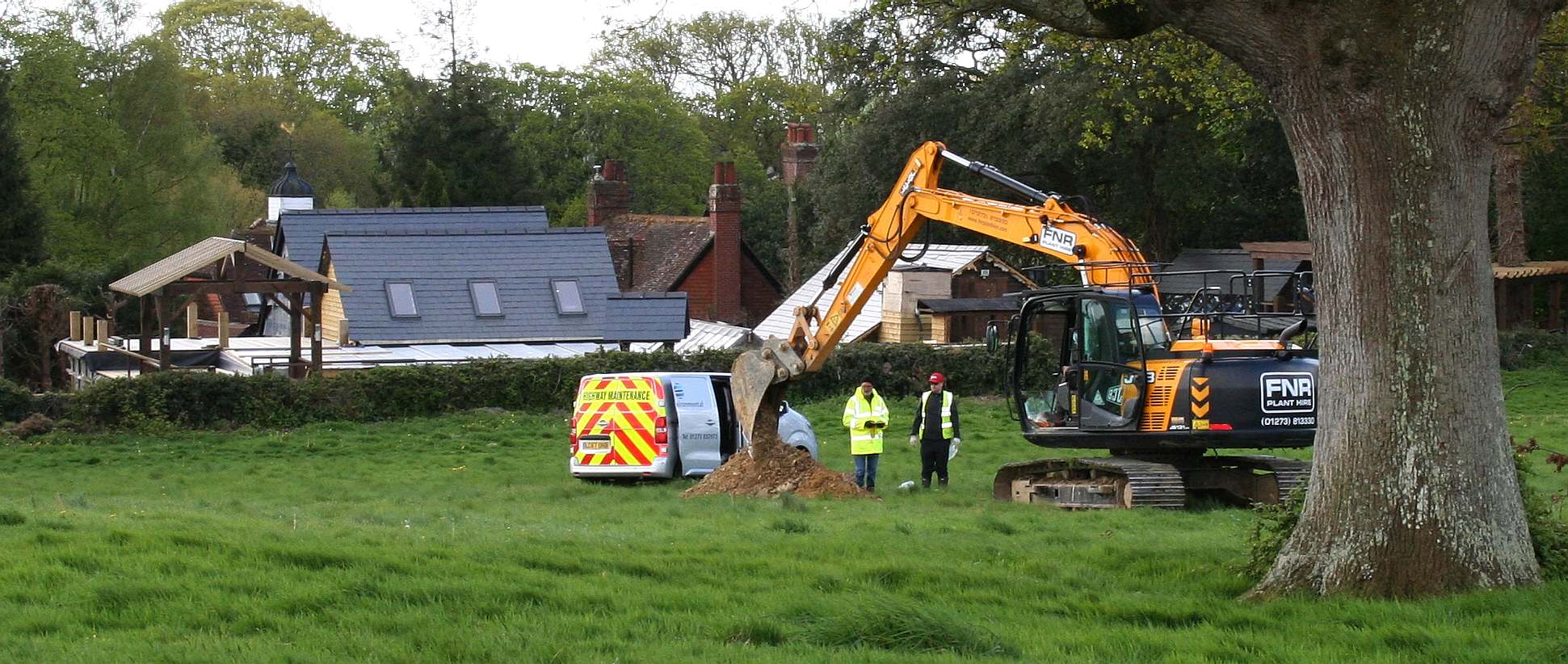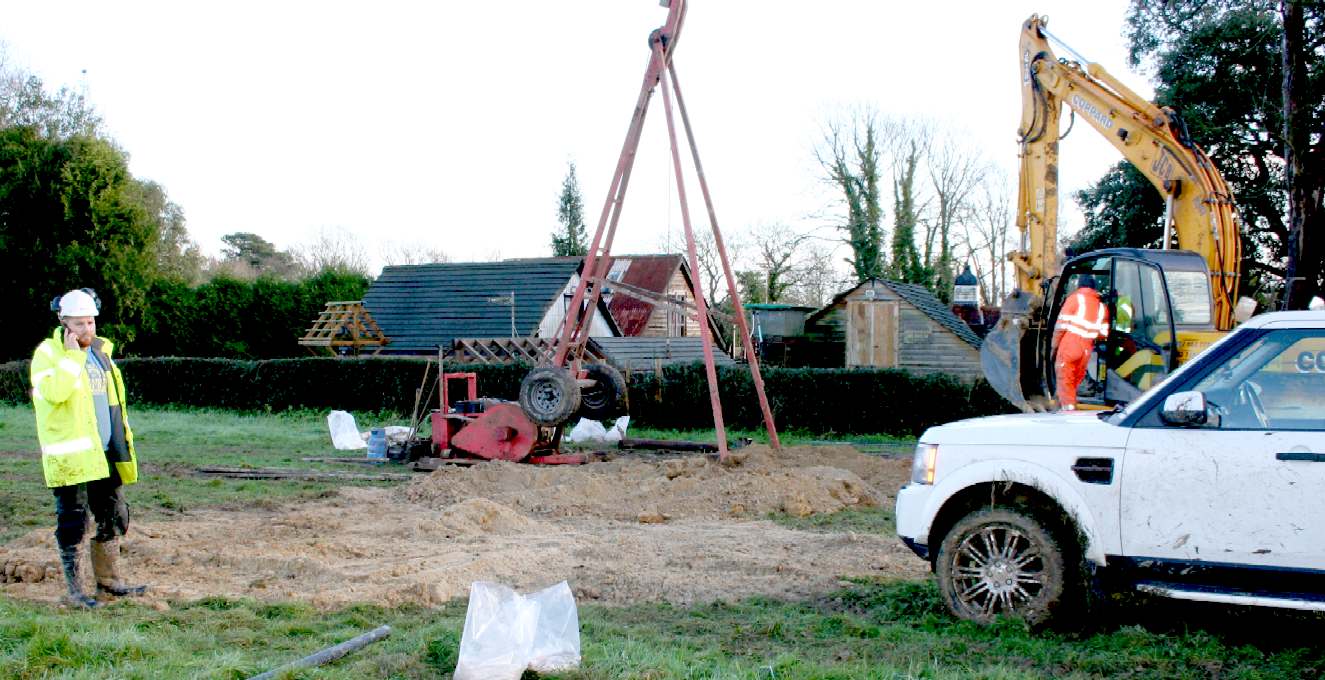|

WATER
RIGHTS - Clarion Housing Group and Thakeham
Homes are in danger of spoiling an ancient well that supplies water
to many concerns in this vicinity. In the picture you can see a hired
digger scooping out trenches to test drainage by pouring in water and
measuring the rate of absorption by the soil. It seems to us that if you
build houses on the ground that feeds the ancient well, that
contamination from garden treatments such as Roundup and engine oils,
etc., will find its way into this well leading to claims against the
owners of the houses who would have been sold a pup, and/or against the
Council for approving the proposal, by way of a negligence claim, and/or
against the vendors or developers. Any way you look at it the developers
and Council concerned should take steps to ensure that no development
takes place until the proper tests and evaluations have been completed,
and after that stage, to ensure that any houses built in this location
will not be on a path that includes the water
table that feeds the ancient well.
Any
failure to conduct the proper tests and house situation, along with safe
sewage disposal, may tempt the Secretary
of State to call in the application. We imagine that all of those
with a financial interest in this piece of greenbelt will want to
resolve issues before it starts to get complicated.
6.
DELIVERING A WIDE CHOICE OF HIGH QUALITY HOMES
47. To boost significantly the supply of housing, local planning authorities should:
●● use their evidence base to ensure that their Local Plan meets the full,
objectively assessed needs for market and affordable housing in the
housing market area, as far as is consistent with the policies set out in this
Framework, including identifying key sites which are critical to the delivery
of the housing strategy over the plan period;
●● identify and update annually a supply of specific
deliverable sites
sufficient to provide five years worth of housing against their housing
requirements with an additional buffer of 5% (moved forward from later
in the plan period) to ensure choice and competition in the market for
land. Where there has been a record of persistent under delivery of
housing, local planning authorities should increase the buffer to 20%
(moved forward from later in the plan period) to provide a realistic
prospect of achieving the planned supply and to ensure choice and
competition in the market for land;
●● identify a supply of specific, developable12 sites or broad locations for
growth, for years 6-10 and, where possible, for years 11-15;
●● for market and affordable housing, illustrate the expected rate of housing
delivery through a housing trajectory for the plan period and set out a
housing implementation strategy for the full range of housing describing
how they will maintain delivery of a five-year supply of housing land to
meet their housing target; and
●● set out their own approach to housing density to reflect local
circumstances.
48. Local planning authorities may make an allowance for windfall sites in the
five-year supply if they have compelling evidence that such sites have
consistently become available in the local area and will continue to provide a
reliable source of supply. Any allowance should be realistic having regard to
the Strategic Housing Land Availability Assessment, historic windfall delivery
rates and expected future trends, and should not include residential gardens.
49. Housing applications should be considered in the context of the presumption
in favour of sustainable development. Relevant policies for the supply of
housing should not be considered up-to-date if the local planning authority
cannot demonstrate a five-year supply of deliverable housing sites.
50. To deliver a wide choice of high quality homes, widen opportunities for home
ownership and create sustainable, inclusive and mixed communities, local
planning authorities should:
●● plan for a mix of housing based on current and future demographic
trends, market trends and the needs of different groups in the community
(such as, but not limited to, families with children, older people, people
with disabilities, service families and people wishing to build their own
homes);
●● identify the size, type, tenure and range of housing that is required in
particular locations, reflecting local demand; and
●● where they have identified that affordable housing is needed, set policies
for meeting this need on site, unless off-site provision or a financial
contribution of broadly equivalent value can be robustly justified (for
example to improve or make more effective use of the existing housing
stock) and the agreed approach contributes to the objective of creating
mixed and balanced communities. Such policies should be sufficiently
flexible to take account of changing market conditions over time.
51. Local planning authorities should identify and bring back into residential use
empty housing and buildings in line with local housing and empty homes
strategies and, where appropriate, acquire properties under compulsory
purchase powers. They should normally approve planning applications for
change to residential use and any associated development from commercial
buildings (currently in the B use classes) where there is an identified need for
additional housing in that area, provided that there are not strong economic
reasons why such development would be inappropriate.
52. The supply of new homes can sometimes be best achieved through planning
for larger scale development, such as new settlements or extensions to
existing villages and towns that follow the principles of Garden Cities.
Working with the support of their communities, local planning authorities
should consider whether su ch opportunities provide the best way of
achieving sustainable development. In doing so, they should consider
whether it is appropriate to establish Green Belt around or adjoining any
such new development.
53. Local planning authorities should consider the case for setting out policies to
resist inappropriate development of residential gardens, for example where
development would cause harm to the local area.
54. In rural areas, exercising the duty to cooperate with neighbouring authorities,
local planning authorities should be responsive to local circumstances and
plan housing development to reflect local needs, particularly for affordable
housing, including through rural exception sites where appropriate. Local
planning authorities should in particular consider whether allowing some
market housing would facilitate the provision of significant additional
affordable housing to meet local needs.
55. To promote sustainable development in rural areas, housing should be
located where it will enhance or maintain the vitality of rural communities.
For example, where there are groups of smaller settlements, development in
one village may support services in a village nearby. Local planning authorities
should avoid new isolated homes in the countryside unless there are special
circumstances such as:
●● the essential need for a rural worker to live permanently at or near their
place of work in the countryside; or
●● where such development would represent the optimal viable use of a
heritage asset or would be appropriate enabling development to secure
the future of heritage assets; or
●● where the development would re-use redundant or disused buildings and
lead to an enhancement to the immediate setting; or
●● the exceptional quality or innovative nature of the design of the dwelling.
Such a design should:
–– be truly outstanding or innovative, helping to raise standards of design
more generally in rural areas;
–– reflect the highest standards in architecture;
–– significantly enhance its immediate setting; and
–– be sensitive to the defining characteristics of the local area.
CONTACTS
Department for Communities and Local Government
Eland House
Bressenden Place
London,
SW1E 5DU
United
Kingdom
Telephone: 030 3444 0000

HINKLEY,
CALIFORNIA - GROUND WATER CONTAMINATION - The
town of Hinkley, California,
located in the Mojave Desert, (about 121 miles driving distance
north-northeast of Los Angeles) had its groundwater contaminated with
hexavalent chromium starting in 1952, resulting in a legal case
against Pacific Gas & Electric (PG&E) and a multimillion-dollar
settlement in 1996. The legal case was dramatized in the film Erin
Brockovich, released in 2000.
Residents of Hinkley filed a class action against PG&E,
encaptioned Anderson, et al. v. Pacific Gas and Electric (Superior Ct.
for County of San Bernardino, Barstow Division, file BCV 00300.
In 1993, Erin Brockovich, a legal clerk to lawyer Edward L. Masry,
investigated the apparent elevated cluster of illnesses in the
community linked to hexavalent chromium. The efforts of Brockovich and
Masry, and the plight of the people of Hinkley, became widely known
when the film Erin Brockovich was released in 2000.


After
many arguments, the case was referred to arbitration with maximum
damages of $400 million. After the arbitration for the first 40 people
resulted in roughly $110 million,
PG&E reassessed its position and decided to end arbitration and
settle the entire case. The case was settled in 1996 for $333 million,
the largest settlement ever paid in a direct-action lawsuit in U.S.
history.
In 2006, PG&E agreed to pay $295 million to settle cases involving
another 1,100 people statewide for hexavalent chromium-related claims.
In 2008, PG&E
settled the last of the cases involved with the Hinkley claims for $20
million.
LEAD
CASE: In the case of Wealden
District Council and planning application WD/2015/0090/MAO,
originally filed by Tim
Watson in 2014, then re-filed by Gleeson
Developments in 2015, and taken over by Clarion
Group and Thakeham
Group, there appear to be multiple errors in applying these
policies to greenbelt, including failing to protect open spaces and
the historic built environment, and not promoting sustainable
transport.
The
Horse
Sanctuary Trust are following this case with much interest. We
consider that the paper trail will eventually make interesting
reading, leading us to who is making the decisions and the money
........

GREENBELT
- Digging up Greenfield sites for quick
profits from windfall planning consents is ruining the heritage of
the nation. Once it is gone, it is gone. Britain is short of genuinely
affordable housing that developers are loath to provide where all they
want is the money. It may be that Clarion Housing and Thakeham intend
building affordable units on this site. They should also bear in mind
the requirement for sustainable development in United
Nations terms. Copyright photograph © April 26 2018, Herstmonceux
Museum Limited. All rights reserved. You may not copy this picture
except for educational
use.
|




